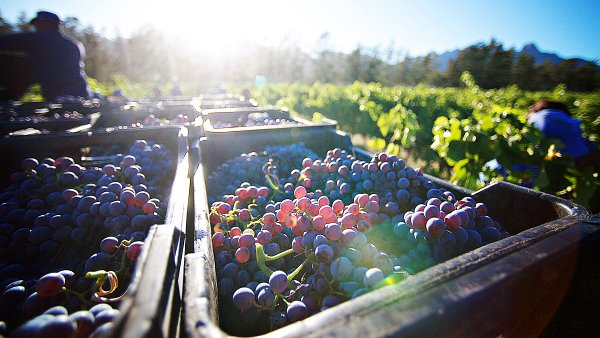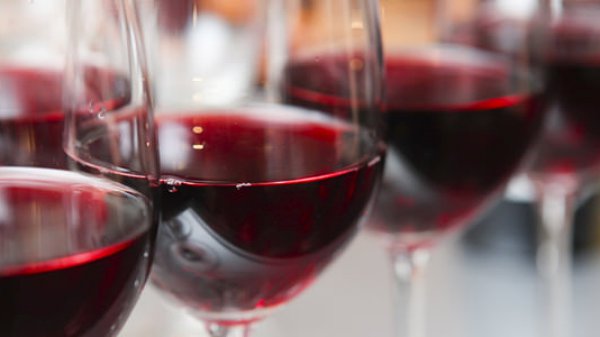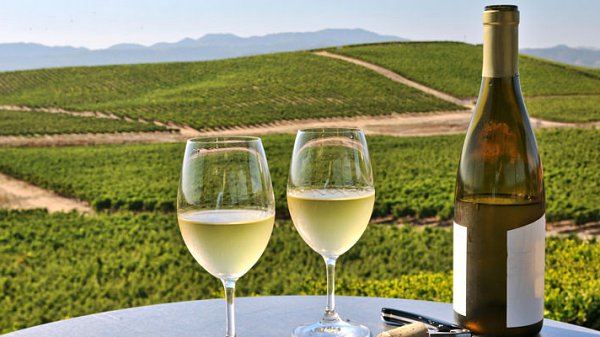In collaboration with Saint Pierre Kuala Lumpur
In this episode, which is also the first episode of our wine series, we have Saint Pierre Kuala Lumpur to look at the different types of wine and how to choose the right one.
It has been said that “Beer is made by men, wine by God”, and it’s not just a witty saying.
To make beer requires hops, malted barley and some knowledge about brewing. But to get wine, all one needs to do really is to leave a bunch of grapes to ferment naturally.
The keyword here is “natural” because wine is basically grape juice. Grapes’ sugars are transformed into ethyl alcohol by the yeast that is naturally presented on the grape skins. That is why the first person to have become tipsy was probably some hungry caveman who ate grapes that had been left around for too long.

Wine grapes are grown until they are ripe, then crushed together and fermented using yeasts to form an alcoholic solution.
Cre: winemag.com
The Story of Wine
Winemaking and viticulture are a slightly different story.
While grapes left to ferment on their own can produce a beverage resembling the kind of wine we are used to, human intervention is required to produce something more palatable.
The history of wine dates back to 7,000 BC when a grape-based fermented drink was discovered in China.
Since then, evidence of winemaking has been found in the ancient Middle East (now known as modern Europe).
After ancient Greek seafarers brought the grapevine home from their travels, vineyards began sprouting up across the Mediterranean from 1,400 BC.

Greeks being a native maritime people brought vines from their homeland and planted them in southern France. Those vines subsequently spread all the way to Spain.
Cre: Flickr.com/Derek Key
Then the Roman Empire propagated viticulture as they notched up conquest after conquest, and very soon, they and the rest of the world discovered that the most delicious wines are produced in temperate countries.
That is why places with cooler climates like France and Germany, Spain, Italy, the United States, Australia and New Zealand make some of the world’s most popular wines today.
Types of Grapes
The type of wines produced depends on the type of grapes grown.
Black grapes make red wine. Green or yellow grapes for white wine, while rosé wine – depending on the method – can be made from dark-skinned grapes or with a combination of other grapes.
Among the most common white grape varieties are Chardonnay, Sauvignon Blanc and Riesling. For red wine, the most popular black grapes are Cabernet Sauvignon, Pinot Noir, Merlot and Syrah.
White Wine
White wine is not really white in colour. It can range from light yellow to intense golden, depending on the grape it was made from and its age. The intensity of colour in white wine can indicate the richness of the wine.

1. Vinho Verde / Pinot Gris, 2. Sauvignon Blanc, 3. Marsanne / Chenin Blanc / Viognier, 4. Chardonnay, 5. Old White Wine, 6. Sherry
Cre: winefolly.com
In general, the taste of white wine is softer and lighter than red wine.
It should also be served well-chilled, at about 10 degrees Celsius compared to red wine, which can be warmer at a temperature of around 15 degrees Celsius.
Another important characteristic that differentiates white wine from red wine is the former is generally more acidic.
Red Wine
By contrast, red wine is more tannic, which means it can taste dry, bitter or astringent. Tannin occurs naturally in grape skins, seeds and stems. Oak barrels in which wine is sometimes fermented also have tannins.
During the winemaking process, white grape skins are removed early because they do not add as much character to the wine as the grape pulp.
But black grape skins impart colour, tannins and fruity flavours to the wine, so they remain for long as they are critical to fermentation.

Red wines are loved for their soft, rich, and velvety flavors, whereas white wines are loved for their zesty acidity, floral aromas, and pure fruit notes.
Credit: vinepair.com
Sparkling Wine
The bubbles and fizz in sparkling wine are no more than carbon dioxide that has been trapped and not allowed to escape. While this is the result of fermentation, excess CO2 can also be engineered by injecting the gas.
There are many types of sparkling wine, with the most famous being champagne. Not every wine of effervescent quality can be called champagne, however; only those produced in the Champagne region of France can be labelled such.
That is why there is Prosecco from Italy and cava from Spain. Sparkling wine can be dry, semi-dry or sweet. Although often considered an aperitif, good sparkling wine can be a suitable accompaniment at dinner time too

Good sparkling wine can be a suitable accompaniment at dinner time too.
Credit: splendidtable.org
Alcohol Content
During fermentation, yeast converts the grape sugars into alcohol. Since riper grapes have more sugars, they also produce more alcohol in the wine.
In general, red wine usually has more alcohol by volume compared to white wine. This is because the black grapes for red wine are riper since they are picked later than the green grapes for white wine.
The alcohol content for white wine can be as low as 8% although they can occasionally rise to as high as 15%. But for red wine, it often ranges from 12% – 15%.
Red or white?
One question that some guests at a fine dining restaurant may find confusing sometimes is, which wine to choose – red or white?
The answer is simple: choose whatever you like; there is no right or wrong.
Once you have decided white or red wine, you can easily pick from two or three of the common grape varietals.
At Saint Pierre Kuala Lumpur, there is a wide range of quality wines that are affordable, either by the glass or bottle. You are most welcome to ask the sommeliers for the wine list and share your drinking preferences with them. The sommeliers’ expert knowledge will certainly be able to find something to suit your palate and budget.

Sommeliers study the regions, grape varietals, wine preparation methods, and so much more and take exams to become qualified.
Cre: drinks.world
Wine Characteristics
If you have chosen a white wine, first note its hue.
When it is young, white wine can be pale yellow or straw-coloured. Swirl it in its glass gently before sniffing and you may detect fruity and floral aromas. Sip it and it should burst with freshness and acidity.
With some ageing, a white wine’s colour may darken and take on a lemony or golden shade.
To the nose, its bouquet may have more honeyed notes. On the palate, perhaps more mellow with ripe fruit.
Next, red wine.
Depending on the age, grape varietal and where it’s from, red wine may be light, full-bodied or a massive fruit-bomb.
But always remember the most important thing about wine: It doesn’t matter what you drink as long as you enjoy it.
Popular White Wines
Chardonnay and Sauvignon Blanc are two of the most popular white wines.
In generally, mid-priced Chardonnay should be light and easy-drinking, with some fruity aromas like apple and citrus, and perhaps a hint of vanilla or minerality.
Or it could be medium-bodied and exhibit Chardonnay’s characteristic creamy or buttery flavours.
But whatever its taste, it will not be sweet and is likely to be drier with moderate acidity and alcohol.
And when it comes to food pairings, Chardonnay, in general, goes well with shellfish, white fish, chicken and even pork. It is also nice with lighter cheeses, which means it will match a creamy pasta superbly.

Chardonnay is one of the most planted white grape varieties across the world.
Cre: vinepair.com
Sauvignon Blanc is another white wine known to be light and fruity. The characteristic bouquet of Sauvignon Blanc has lychee and passion fruit, perhaps with floral and citrus overtones. Because of its freshness, it is also sometimes described as grassy.
Sauvignon Blanc can be dry but it should generally be sweeter than Chardonnay.
It is great with salads, crab, fish, chicken, turkey and pork. It can also handle stronger cheeses.
Popular Red Wines
Cabernet Sauvignon, Merlot, Pinot Noir and Syrah are among the most recognisable red wines, with Cabernet Sauvignon arguably being the best-known.
The Cabernet Sauvignon grape is small with a thick black skin. The wine made with such grapes is thus dark red in colour, usually with strong and bold fruit and tannins.
When aged, it may be rounder and more balanced as the tannins and fruit – usually cherry and raspberry – soften.
Cabernet Sauvignon is perfect with red meat like steak. And because of its concentration and sweetness, it can also be a surprisingly good match with spicy food.
Merlot is a bit like Cabernet Sauvignon, with flavours of red fruit but softer and smoother. It is thus easier to drink as well as pair with food.

If you must show off when ordering a French Merlot, try to remember that it is the dominant grape grown in the Right Bank of Bordeaux, one of the most famous areas in the wine world. This is opposite the Left Bank, where Cabernet Sauvignon is typically cultivated.
Cre: tara-inn.com
On the other hand, the Pinot Noir grape is larger than the Cabernet Sauvignon and has a thinner skin. Wine made from the Pinot Noir grape is lighter in colour and taste, with more subtle tannins.
The most famous (and expensive) French Pinot Noir comes from Burgundy. More affordable but still appealing options can be found in Australia and France.
Pinot Noir may be light and fruity, which makes them ideal with a fish dish, or lush and velvety, which suits meat like pork.
Finally, Syrah wine is darker in colour than Pinot Noir. It can be medium- to full-bodied like a Merlot but with a distinctive difference – it has a slight peppery taste, which makes it an excellent choice with food that is prepared with spices and/or herbs.
Now, make a reservation in restaurants with good wine lists and enjoy the indulgence!
